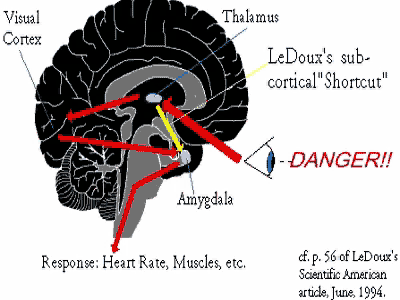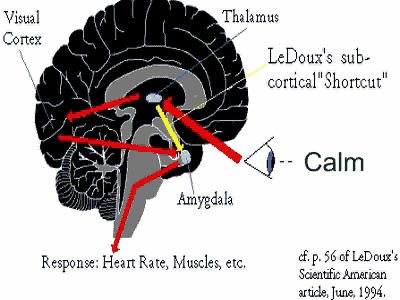IT’S NOT JUST FOR VETERANS – THE RESULTS WITH BRAINPAINT®
PTSD symptom reduction was tracked among 829 clients receiving neurofeedback training from BrainPaint® Authorized Professionals located around the world. When clients began the process they reported systems including: flashbacks, intrusive thoughts, re stimulation and reliving trauma. People with post traumatic stress disorder report the most significant progress after the fewest number of sessions.
THE WARRIOR BRAIN
The MAO-A gene (monoamine oxidase A) has been the target of considerable research, and is also known as the “warrior gene” because it regulates serotonin in the brain. Serotonin affects your mood, and many scientists believe that if you have a certain version of the warrior gene, your brain won’t respond to the calming effects of serotonin. In many people this gene is dormant unless stimulated by war or a traumatic event.
Fear should be our ally since it protects us from danger through a chemical reaction signaling us to pay attention to a threat. It triggers the classic fight-or-flight response—sweaty palms, dry mouth, an increase in breathing and heart rate, a jolt of adrenalin—to help us survive. When the brain doesn’t return to normal after a stressful incident, or when there are too many events, this hormone-driven alert system can become harmful. Contemporary warfare using unconventional tactics and weapons has been especially hard on soldiers. Add to that multiple combat tours with little time in between to recover, and it becomes a recipe for creating trauma.
WHAT DOES IT FEEL LIKE?
PTSD, or Post Traumatic Stress Disorder, is being stuck in a state where tormenting thoughts from your past keep replaying again and again.
If someone with this anxiety disorder sees something familiar to the original traumatic events, then it will re-stimulate the earlier trauma. The traumatized person will report feeling “emotionally polluted” for hours or days.

The Path of a Hijacked Brain – When the brain bypasses executive functioning and goes straight to survival mode – fight or flight – without considering alternative solutions, the actual gravity of the situation or consequences.

The Path of a Calm Brain – The prefrontal cortex or higher brain, evolved over time to help with an optimal fear response: accurately assessing risk, saving room for cognitive thought and rapidly returning to baseline when danger passes.
WHAT IS PTSD?
Post traumatic stress disorder was officially recognized in 1980 when it was included as an anxiety disorder in the 3rd edition of the Diagnostic and Statistical Manual of Mental Disorders (DSM-iii). It is defined as an anxiety disorder that some people get after experiencing or witnessing an event “outside the range of usual human experience.” The sufferer continues to re-experience the original memories and have intrusive thoughts about the scary experience.
No one knows why two people who experience the same event can have a different reaction. One person may develop post traumatic stress while the other person bounces back to a normal level of functioning.
Susceptibility to post traumatic stress may depend on many factors including genes, child abuse, the severity of the trauma, the duration of the trauma or a person’s brain structure and functioning. What we do know is that people with post traumatic stress disorder are at a higher risk to attempt suicide. A study published in the Archives of General Psychiatry in 2009 demonstrated that youths who had post traumatic stress were five times more likely to attempt suicide than youths who had been exposed to trauma, but did not develop the disorder. The American Psychological Association (APA) reports that a person with this disorder is six times more likely to attempt suicide than a person from the general population.
People with post traumatic stress re-live the trauma in their mind, body and/or sometimes even visualize it happening over again. These are called flashbacks. A traumatized person may begin efforts to avoid thoughts, feelings or conversations about the event. He or she will often engage in a very busy life, because it is during idle moments that intrusive thoughts and memories haunt them. Triggers that originally frightened them may begin to generalize to other things and activities, which causes their world to shrink. They usually become increasingly cautious and phobic.
WHAT ARE THE SIGNS OF PTSD?
Symptoms are the same for children, teens and adults, however, depending on age individuals may engage in different behaviors.
AN EASY SOLUTION FOR PTSD
Within 5 bi-weekly alpha-theta neurofeedback sessions there should be PTSD symptom reduction.
EEG biofeedback (also known as neurofeedback), specifically alpha-theta protocol, is a training process that has been scientifically-proven to improve post traumatic stress disorder. It helps with issues that people develop as the result of trauma, grief, phobias or dysfunctional family systems.
Alpha-theta protocol is named after the two main types of brainwaves that are involved during the neurofeedback training process. There is no talking involved. The client listens to feedback from his or her brain, which brings on a deep calm witness state. People can often observe or think about their dislodged memories in this safe dream-like state. Negative response patterns operating on a sub-conscious level release trauma and old or false beliefs so the client can enjoy life with a new and healthier perspective.
In addition, the brain becomes receptive to complementary psychological therapies that might otherwise have created avoidant or defensive reactions.

People who experience alpha-theta training report:
THE EVIDENCE FOR NEUROFEEDBACK
Randomized Controlled Trial
One PTSD study was done with three groups of Veterans:
- Veterans with the diagnosis who received neurofeedback & talk therapy;
- Veterans with the diagnosis who only received talk therapy;
- Veterans without the diagnosis who received no assistance.
Conclusion:
All of the Veterans in the group who received neurofeedback eliminated their post traumatic stress symptoms and had a significant decrease in their blood stress hormone levels (beta endorphins). Upon the completion of the study the neurofeedback group had similar profiles to the the Veterans who had never been diagnosed with post traumatic stress disorder. The talk therapy group had an increase in stress hormones, and did not eliminate any of their trauma.
A ten year follow up on the Veterans who had been in the neurofeedback group revealed that none of the living Veterans met the diagnostic criteria for post traumatic stress disorder.
Outcome Study
Another PTSD study was conducted by Bill Scott, CEO of BrainPaint®, and Dr. Eugene Peniston. It was an outcome study with 24 Native Americans who had post-traumatic stress disorder at the Northland Recovery Center in Grand Rapids, MN in 1995. Upon the completion of the study none of the Veterans met the diagnostic criteria for Post Traumatic Stress Disorder anymore. The scientists also conducted a 12-18 month follow-up, and 100% of the Veterans who participated in the study remained free from post traumatic stress disorder.
Double-blind Placebo Trial
There is also a double-blind placebo trial on the effects of alpha-theta neurofeedback on personality and mood. In conclusion, there were significant improvements found for the Profile Of Mood States (POMS), with real feedback producing higher overall scores than mock feedback (P = 0.056).
PROFESSIONALS WHO CAN HELP
When looking for a neurofeedback provider:
A person may receive other neurofeedback protocols in addition to alpha-theta, but the training will always include some alpha-theta.
For a comprehensive directory of neurofeedback providers who have been properly trained in alpha-theta and
use evidence-based neurofeedback equipment:

